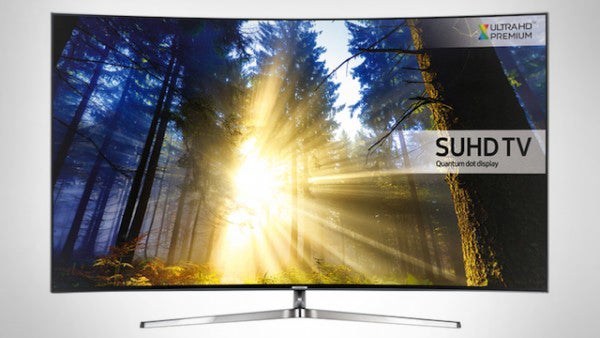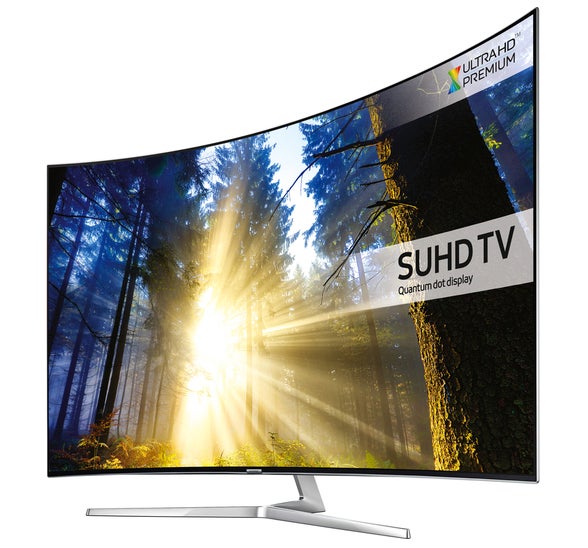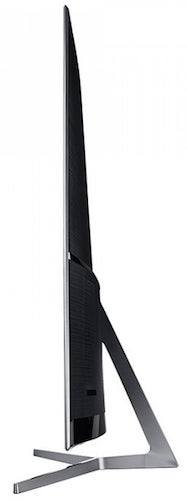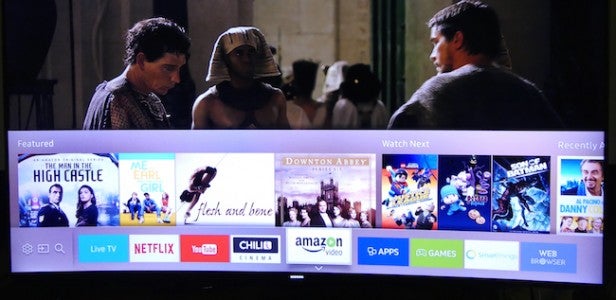Samsung UE55KS9000 Review
Samsung UE55KS9000
Pushes for UHD and HDR perfection with spectacular results

Sections
- Page 1 Samsung UE55KS9000 Review
- Page 2 Picture Quality Review
- Page 3 Sound and Conclusions Review
Verdict
Pros
- Incredibly bright, dynamic and colourful HDR pictures
- Standard dynamic range pictures look brilliant too
- Much-improved smart interface
Cons
- Some backlight banding with HDR
- No 3D support
- Curved screen not ideal from wide viewing angles
Key Specifications
- Review Price: £2099.00
- 55-inch LCD TV with edge LED lighting
- Native UHD/4K resolution
- HDR playback with 1,000-nit light output
- Tizen-based smart TV operating system
- Multimedia playback via DLNA and USB
What is the Samsung UE55KS9000?
The 55-inch UHD UE55KS9000 TV is the first model from Samsung’s brand-new 2016 range. It boasts a revamped version of Samsung’s Tizen-based smart TV system and, for the first time ever in a TV (rather than professional monitor), it manages to deliver 1,000 nits of brightness from edge LED technology.
This is a big deal, since it makes the UE55KS9000 the first edge-lit TV to meet the specifications required to earn the HDR-based Ultra HD Premium badge of honour.
Video: Trusted Explains: All you need to know about TVs
Samsung UE55KS9000 – Design and Features
After flirting with chunky, boldly angled screen frames on its 2015 high-end TVs, Samsung has decided to return to slim surrounds for its 2016 models. On seeing the super-sleek UE55KS9000, this is a decision of which I wholeheartedly approve. The TV look much less intrusive in your room when it’s turned off, while leaving you more able to get lost in the picture quality when it’s turned on.
The UE55KS9000 also continues Samsung’s push for “360-degree” designs. This comes courtesy of an attractively finished, rivet-free rear that’s given added panache via a strip of glinting metal running across its middle. Also adding to this is the chrome desktop stand, whose neck angles sharply out of its centre.
To be honest, I continue to wonder just how many people really care about the look of the rear. Although I guess the UE55KS9000’s use of a curved screen does mean it’s marginally more likely that some of the TV’s rear will be on view in certain seating positions.
In keeping with the past few generations of Samsung’s high-end TVs, most of the UE55KS9000’s connections – most notably four UHD-friendly HDMIs, two USBs and both satellite and terrestrial tuner feeds – are housed on an external connections box. A further USB and the Ethernet port are found on the main TV chassis.
You may think from this external connections box that the UE55KS9000 still supports Samsung’s Evolution Kit technology, whereby you can keep upgrading your Samsung TVs with future connectivity options, smart TV systems, and video processing just by buying a future external connections/processing box. In reality, though, Samsung has actually ditched Evolution Kit support for its entire 2016 range.
This is a shame. While few people actually bothered investing in upgrade kits for their TVs – which is, according to Samsung, why it’s no longer supporting the feature – it was always reassuring to know that, in a fast-changing TV world, a high-end Samsung set could at least keep up for a year or two longer than rival brand’s units.
Related: Best TVs 2016

There’s no 3D support at all on this TV, or any other 2016 Samsung model. This will clearly be a hammer blow to the small but passionate 3D fan base out there, but Samsung claims there just isn’t enough interest in 3D any more to justify offering it when there are new features such as HDR on which to concentrate.
Which is exactly where Samsung is focusing its efforts for 2016. The brand has completely redesigned the KS9000’s panels from those used in their JS9000 predecessors to meet the tough demands of HDR – and the expanded colour gamuts that routinely go with the technology.
In particular, Samsung has returned to Quantum Dot colour technology to deliver a wider colour spectrum. The UE55KS9000 claims 96% of the DCI-P3 digital cinema colour range that’s now seemingly established as the most sensible target for the new generation of HDR video content. Plus, it’s shifted from a horizontal mounting arrangement for its edge LEDs to a vertical one.
This backlight adjustment is potentially controversial, since historically, vertical edge LED lighting – as used by LG LCD TVs, predominantly – has tended to cause more distracting lighting problems in pictures than horizontally organised systems.
However, the vertical approach is currently the only way to get the light output of an edge LED TV to 1,000 nits – and so far as Samsung is concerned, hitting 1,000 nits is essential if you really want to express what HDR is capable of.
In fact, 1,000 nits is apparently the brightness level to which current Ultra HD Blu-rays are being mastered. As a result, it’s only if your screen can deliver the same brightness will you experience full HDR that hasn’t had its luminance information “downmastered” to suit a lower brightness screen. Or so the argument goes.
Related: Samsung 65KS9500 hands-on

Samsung has an extra interest in pushing this argument, of course, since it raises doubts over the ability of rival LG’s OLED technology to give full expression of HDR content.
That said, it’s important to remember that while hitting 1,000 nits enables the UE55KS9000 to earn the industry’s new Ultra HD Premium badge of honour, that badge can also be earned by TVs that deliver much less brightness so long as they’re able to produce exceptionally deep black levels. Like LG’s upcoming new OLED TVs…
There are two final, potentially cool, new picture features on the UE55KS9000. The first is its use of a moth eye-style filter on the screen, which is designed to reduce on-screen reflections and tackling one of the biggest issues I have with curved screen TVs. The second is a “SUHD Remastering” system that Samsung claims will convert SDR content of the sort most of us will still be watching for the majority of our viewing time into something that looks like HDR.
Unfortunately, though, SUHD Remastering isn’t yet finalised, so I was unable to test it. It will apparently be added via a firmware update later in the year.
Samsung has made some fairly major changes to its Tizen-based smart TV system for 2016. In particular, it’s added a second tier of icons that’s used to show content “exploded out of” whichever icon you have selected on the bottom, original tier. Similar to the system employed in the main business area of the latest Apple TV interface, it works well – at least with those apps that support the ‘exploded content’ feature – and makes navigation feel far more intuitive and connected.
The system is also exceptionally easy to customise, so that your favourite apps can always have pride of place on the homescreen.
It’s worth adding that the system carries a strong range of apps, including the 4K versions of Netflix and Amazon, and now runs much more quickly and stably than it did last year.
Related: Samsung UE32J6300 review
There’s still something slightly business-like about the interface’s presentation compared with the friendlier look of LG webOS and Panasonic Firefox TV systems. For the most part, however, Samsung’s latest smart system is a great improvement on what’s gone before and shows a good understanding of the sort of simplicity most TV users want from a smart TV interface.
Samsung UE55KS9000 – Setup
The UE55KS9000 does a decent job of holding your hand through the initial setup, and Samsung has simplified its onscreen menus in two useful ways. First, it’s removed some of the largely pointless sub-menus from the picture set-up menu. And second, the TV’s Game preset – designed to minimise the time it takes for the TV to render images, to support video gaming – has finally been moved into the picture set-up menus, rather than being buried in the System folder.
To get the best from the UE55KS9000’s pictures, with standard dynamic range content in particular, I’d recommend reducing the backlight setting to around its 9 level – at least for serious movie viewing in a dark room – to get the deepest and most evenly lit black levels.
When the UE55KS9000 recognises an HDR input, it will automatically adjust its picture settings – most notably pushing the backlight right up to its maximum 20 level to deliver the 1,000 nits required.
Each picture preset offers a slightly different flavour of HDR, however, and unlike the company’s 2015 HDR TVs Samsung lets you adjust every aspect of the HDR presets. If you want to get that 1,000 nits figure for accurate mapping of HDR’s full luminance range, though, you’ll need to leave the backlight setting untouched. Even though this can, as we’ll see, lead to some backlight issues.
A couple of other, more general points worth making are that you should ensure all noise-reduction systems are turned off for HD and 4K sources, and that you don’t use the set’s motion processing on its highest setting, since this leaves images looking excessively processed.
How we test televisions
We test every TV we review thoroughly over an extended period of time. We use industry standard tests to compare features properly. We’ll always tell you what we find. We never, ever, accept money to review a product.

